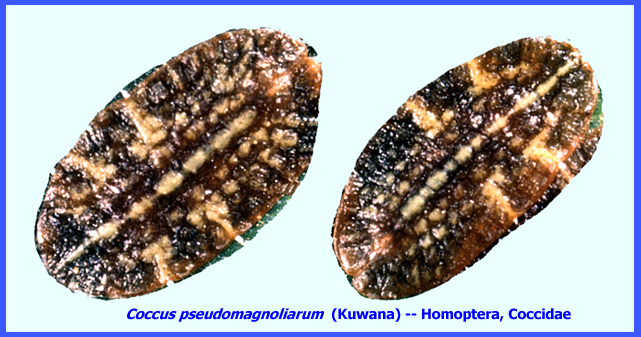FILE: <ch-21.htm> GENERAL INDEX [Navigate
to MAIN MENU ]
|
CITRICOLA SCALE Coccus pseudomagnoliarum (Kuwana)
-- Homoptera, Coccidae (Contacts) ------ CLICK on Photo to enlarge &
search for Subject Matter with Ctrl/F. GO TO ALL: Bio-Control Cases
As of 1991 the only
attempts at biological control of citricola scale were made in
California. Although unsuccessful in
every area except southern California, the results are considered significant
because of the complete lack of progress (Flanders & Bartlett 1964,
Kennett et al. 1999). During
1922-1985 six species of monophagous and oligophagous parasitoids were
introduced from Japan but failed to establish (Gressitt et al. 1953). Citricola scale was eventually controlled
in southern California by a complex of parasitoids, including native,
cosmopolitan and exotic species, the latter being introduced against the
black scale, Saissetia oleae (Bartlett 1953). Under the greater climatic extremes of
central and northern California, the same species of parasitoids were
ineffective in controlling citricola scale on citrus, and it continues to
remain a pest. (Kennett et al. 1999).
A general
failure to establish parasitoids imported from Japan, in particular the
host-specific Metaphycus
orientalis (Compere) and Microterys okitsuensis Compere, is
attributed to an inability to bridge the summer period, at which time the
univoltine, even-brooded host scales are too small for parasitoids to
reproduce (Compere 1924, Flanders & Bartlett 1964, Kennett 1988, Kennett
et al. 1999). Parasitoids that have
moved over to citricola scale after it invaded other countries recently,
suggests that biological control might be possible in the more extreme
climatic conditions of central California (Oncuer 1974, Kennett 1988, Kennett
et al. 1999) (also see Gressitt et al. 1954, Bartlett 1960, Annecke 1963,
Bartlett & Ball 1964, Saakian-Baranova 1965, 1966; and Yasumatsu &
Watanabe 1965). REFERENCES: [Additional references may be
found at: MELVYL
Library ] Annecke, D. P. 1963. The encyrtid and aphelinid parasites
(Hymenoptera: Chalcidoidea) of soft brown scale, Coccus hesperidum
Linnaeus (Hemiptera: Coccidae) in South Africa. South Africa Dept. Agric. Tech. Serv., Ent. Mem. 7. 75 p. Bartlett, B. R. 1953. Natural control of citricola scale in
California. J. Econ.
Ent. 46: 25-8. Bartlett, B. R. 1960. Biological races of the black scale, Saissetia oleae, and their specific parasites. Ann. Ent. Soc. Amer. 53:
383-85. Bartlett, B. R. & J. C. Ball. 1964. The developmental
biologies of two encyrtid parasites of Coccus
hesperidum and their intrinsic
competition. Ann. Ent. Soc.
Amer. 57: 496-503. Compere, H. 1924. A preliminary report on the parasitic
enemies of the citricola scale [Coccus
pseudomagnoliarum (Kuwana)]
with descriptions of two new chalcidoid parasites. Bull. So. Calif. Acad. Sci. 24: 113-23. Flanders, S. E. & B. R. Bartlett. 1964. Observations on
two species of Metaphycus
(Encyrtidae, Hymenoptera) parasitic on citricola scale. Mushi 38:
39-42. Gressitt, J. L. 1953. The coconut rhinoceros beetle (Oryctes rhinoceros) with particular reference to the Palau
Islands. Bul. 212, B. P. Bishop
Museum, Honolulu. 157 p. Gressitt, J. L., S. E. Flanders & B. Bartlett. 1954.
Parasites of citricola scale in Japan, and their introduction into
California. Pan-Pacific Ent. 30: 5-9. Kennett, C. E. 1988. Results of exploration for parasitoids of
citricola scale Coccus pseudomagnoliarum (Homoptera:
Coccidae), in Japan and their introduction in California. Kontyu 56:
445-57. Kennett, C. E., J. A. McMurtry & J. W.
Beardsley. 1999.
Biological control in subtropical and tropical crops. In: Bellows, T. S. & T. W. Fisher (eds.), Handbook of Biological Control:
Principles and Applications.
Academic Press, San Diego, New York.
1046 p Oncuer, C. 1974. The Coccus
species (Homoptera: Coccidae) damaging citrus groves in the Aegean region;
studies on their morphological characters, distribution and natural
enemies. Bitki Koruma Balteni, Suppl.
1. 51 p. Quayle, H. J. 1938. Insects of Citrus and Other Subtropical
Fruits. Comstock Publishing Co.,
Ithaca, New York. 583 p. Saakian-Baranova, A. A. 1965. On the
host-parasite relations between Coccus
hesperidum L. (Homoptera,
Coccidae) and some Encyrtidae. Trudy
Zool. Inst. Akad. Nauk., USSR 45: 733-52. [in Russian w/ English summary]. Yasumatsu, K. & C. Watanabe. 1965. A tentative
catalogue of insect natural enemies of injurious insects in Japan. Pt.
II. Host-parasite-predator
catalogue. Kyushu Univ. Faculty
Agric., Ent. Lab. 116 p |
